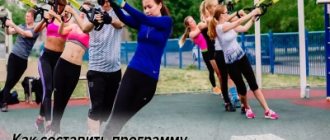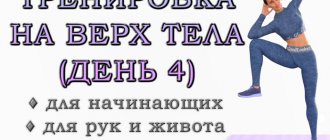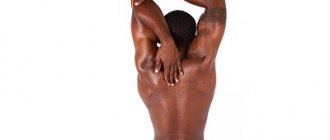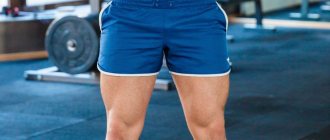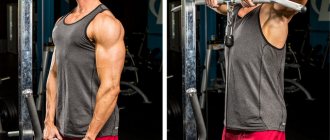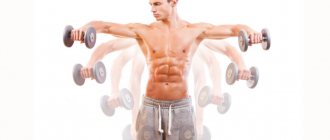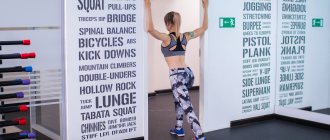Why is it effective to train your chest and shoulders on the same day?
If the thought of combining shoulders and chest in one workout doesn't shock you, it's time to move on to the benefits of such a split. It is important to understand that despite the popular combinations, which are based on the development of antagonist muscles, this split uses a completely different principle. Work on each group is based on the stress consolidation method, where similar muscle groups are intelligently combined.
There are two main types of splits for training the shoulders and chest. The first is based on working out the chest, as well as the front deltoids, which will already receive a load in the pressing movements, in one workout. In most cases, exercises for the middle deltoids are added to this training. In this case, the posterior head will be worked out on back day, which also relates to the principle of stress consolidation.
The second option is simpler - you simply train the muscle groups of the pectoral and shoulder muscles in one workout, including all three deltoids. In this case, exercises for the pectoral muscles are done first, and the shoulders are achieved in the second half of the workout.
What benefits can this split provide? Among the main advantages are:
- The ability to focus on large muscle groups (by including shoulders on other days);
- Increasing the effectiveness of training and progression through proper shoulder training;
- Reducing the total time for shoulder training without loss of efficiency (to properly work out the deltoids, it is enough to complete 3-4 exercises);
- Reduced risk of injury due to shoulder training in static-dynamic mode.
The last point is especially worth highlighting. The practice and experience of professional athletes show that static-dynamic training for deltoids is superior to classical training in all respects. Moreover, it is incredibly relevant in such splits, where you can perform powerful basic exercises for the main muscle group (in this case, the pectorals), and work out the deltoids in a static-dynamic mode.
The most effective exercises and technique
- bench press in a lying position. The main advantage of this exercise is pumping up different zones of the chest by adjusting the angle of the bench (positive angle - the load falls on the top of the chest, negative - the lower zone is involved).
Lie down on an exercise bench with your gluteal muscles, torso, and back of your head pressed against it. Your feet should be flat on the floor and hip-width apart. The barbell should be taken with a wide grip and raised above the center of the sternum. As you inhale, lower the barbell to your chest until it barely touches and hold your breath.
As you exhale, return the barbell up and hold in this position, concentrating tension in the pectoral muscles. Return the barbell down as slowly as possible, and raise it at an average pace. The number of approaches should be 3-4, 10-12 repetitions;
Important ! Be sure to agree on the support of a partner - insurance is very important during initial training.
- push-ups on parallel bars. During this exercise, a fairly large part of the muscles is involved: pectoral, biceps, muscles of the arms, shoulders and back, abs. The initial position of the body on the uneven bars is a stand with outstretched arms, without bending. This position promotes muscle contraction and optimally prepares the body for subsequent stress. Next, tilt your body forward and, while inhaling, gently lower yourself down. Hold and exhale as you return to the starting position. It is necessary to perform 3 sets of 10 repetitions.
Note! Remember to control your elbows: they should be spread out to the sides while lifting. Also, with this exercise you need to go as low as possible, otherwise the load on the pectoral muscles will be minimal (the triceps will be tense).
Biceps exercises:
- standing barbell lifts. Stand up straight and grab the bar with an underhand grip, placing your hands at shoulder distance. In this case, the elbows should not be brought forward, since in this position it will not be the biceps that will swing, but the deltoids. Next, slowly raise and lower the barbell, bending your elbows. Frequency of repetitions: 3 sets of 10 times;
Important ! Do not jerk or move by inertia, focus on performing this exercise smoothly.
- bending your arms on a bench. While performing this exercise, try to keep your feet flat on the floor and your back flat on the incline bench. Alternately bend your elbows while lifting the dumbbells. In the upper position of the hands, turn the hands towards you. Perform 3 sets of 12 repetitions on each arm.
Recommendations from professionals for creating a program
Amateurs should not always listen to the advice of pros, because they have a completely different attitude towards training, nutrition and the general approach to progression. However, in some cases, only the advice of experienced athletes who already have impressive volumes can be most useful. We have analyzed and collected the main recommendations from world-famous athletes who have proven in practice that they understand how to do shoulders.
Tip #1 – Use Statodynamics
Many athletes of different levels have become convinced that the static-dynamic mode is ideal for the shoulders. Firstly, such training ensures muscle growth even when you have reached a plateau and have not seen progression for years. For beginners, stato-dynamics will also provide many advantages and will protect you from injuries that can occur when working with heavy weights.
Tip No. 2 - the correct ratio of exercises and cycles
It is important to understand that despite the dominance of static-dynamic training, the classics have not been canceled. Any muscle needs a variety of loads to develop, so use different cycles. If you use compound shoulder exercises, do them at the end of your chest workout. After this, give the muscles a little rest and begin to carefully work out the deltas. To do this, it will be enough to perform one exercise at a time. The only exception is the rear delta. if you train all the heads in one day, combining them with the chest, then you can add +1 exercise for the back bun.
Tip #3 – choose the most effective exercises
Stato-dynamics has become a real discovery in fitness. But despite the fact that this technique is ideal for working out the deltoids, it is extremely important to choose the right exercises. For the chest muscles, it is best to use the classics: bench press and dumbbell bench press, incline bench press, dumbbell flyes, pullover, crossover work. For the shoulders - swings in front of you, to the sides, bent over raises, bench presses in the machine, and seated delt raises in the machine.
Tip #4 – don’t chase the scales
Forget about trying your best to increase the weight of the weights when training your shoulders. Firstly, the static-dynamic mode does not require much weight; rather, on the contrary, only slight weighting will allow you to correctly reveal the essence of this technique. Secondly, you should not overload the shoulder joint with heavy weights, therefore, when combining shoulder training with the chest, it is better to give preference to high-quality training with weights of no more than 35-40% of the maximum.
In general, the main thing is to approach the matter correctly, not to perform a large number of exercises for deltas and to focus on the highest quality work on each beam. And of course, it is important to remember that the shoulders need to be trained only in partial amplitude.
Morning fitness workout for the shoulder girdle and arms
To work out the shoulder girdle and effectively lose weight in your arms, you need to include push-ups in 4 sets in your morning exercises, gradually increasing the number of repetitions from 6 to 20 in one approach:
- Take a pose resting on your palms and toes, with your palms exactly at shoulder level. Perform 6 to 8 push-ups with your elbows pulled back.
- Perform 6-8 push-ups, resting on your palms in a wide stance and moving your elbows to the sides.
Morning fitness training for the upper limbs, chest and shoulders must be completed with a cool down:
- Place one upper limb behind your back over your shoulder and head, pressing it with your other hand, and then place your other hand behind your back from below from the waist, and try to reach out and clasp the fingers of both hands behind your back. Change hands and repeat the element.
- Hug yourself with both arms and try to connect your fingers behind your back.
- Clasp your fingers behind your back, squeeze your shoulder blades together and bend, moving your upper limbs back.
Training program
It's time to move from theory to practice, so it's important to shed some light on what a chest and shoulder combination training program should look like. It is important to understand that you should not focus on just one scheme. Try to make changes, do different exercises, for example, alternating dumbbell presses and presses on the middle beam machine, or bent over swings and flyes on the rear beam machine. Remember that the combination of classics and static-dynamics is only a training model. All other principles, such as variety, progression of load, remain undeniable.
It is important to monitor the intensity and volume of your workout. The timing of your workout is important, so try to keep your workout to no more than one hour. This will be enough to fully complete all the necessary “base” for the chest and work out the shoulders in static dynamics. Fortunately, this mode of operation allows you to do approaches quite quickly.
For newbies
Even for beginner athletes, training the chest and shoulders will have its benefits, although the volume of work must be carefully monitored to avoid overtraining. Let's look at two program options that beginners can use as a basis.
Chest, anterior and middle delta:
This option includes a workout where the middle and anterior deltoid muscles are worked with the chest, and the rear group is worked on a separate day with the back muscles. The workout itself will look like this:
- Bench press;
- Incline dumbbell press;
- Lying dumbbell flyes;
- Pullover with dumbbell;
- Swing with dumbbells in front of you;
- Seated dumbbell press.
Now let's look at an example of a workout where you need to perform exercises on the posterior bundle. The program also contains one basic movement for the shoulders.
- Bench press;
- Incline dumbbell press;
- Raising arms in the simulator;
- Pullover with dumbbell;
- Army press;
- Bent-over dumbbell raises;
- Shoulder press in the simulator;
- Lifting a dumbbell in front of you.
It is important to start your shoulders with a basic exercise, then first work the back bunch, and then the middle one. This split is most effective because you do shoulder exercises on one day, leaving other days to work other muscles. It is important to remember that the anterior deltoid, which is used in most presses, is best done at the very end of the workout.
For advanced
In advanced athlete programs, the main difference will be in the volume of training and the number of sets for each exercise. Let's look at two examples of programs of professional and experienced athletes, which vary between medium and heavy deltoids.
The first version of the program involves working out all the delta bundles after the chest muscles. This allows you to reserve other training days for your back, legs and arms, giving all muscle groups an even load.
- Bench press – 4*12, 10, 8, 6;
- Hammer press/incline dumbbell press (for upper pecs) – 4*12, 10, 8, 6;
- Lying dumbbell flyes – 4*12, 10, 8, 9;
- Pullover with dumbbell – 4*12, 10, 8, 6;
- Crossover – 4*12, 12, 10, 8;
- Behind the head barbell press in Smith;
- Machine press/seated dumbbell press;
- Raising the arms for the rear delts with the chest resting on the bench;
- Lifting a dumbbell in front of you while sitting on a bench.
Chest training is performed in the standard mode, shoulders - in static-dynamic mode, in the mode of 40-45 seconds of load at a slow pace and 35-45 seconds of rest for 1 cycle. For each exercise there are 4 cycles. It is important to remember that the deltoid shoulders are usually involved in chest exercises, so only one exercise will be enough for the front beam.
The second training option involves combining only exercises for the anterior bundle with chest training. In this case, the middle and rear deltoids will be worked on back day.
- Bench press/incline – 4*12, 10, 8, 6;
- Dumbbell bench press/incline – 4*12, 10, 8, 6;
- Lying dumbbell flyes – 4*12, 10, 8, 9;
- Pullover with dumbbell – 4*12, 10, 8, 6;
- Crossover – 4*12, 12, 10, 8;
- Lifting dumbbells in front of you in a sitting position;
- Lifting the barbell in front of you while sitting;
Both shoulder exercises are performed with partial range of motion.
Biceps and triceps workout
If everything is bad with the biceps and it’s difficult to load it without lifting barbells and dumbbells, then there are simply plenty of exercises for the triceps. Let's start with them:
- Reverse push-ups from a bench (chair, cabinet, etc.);
- Close grip push-ups;
- Dips.
All movements should also be done at a slow pace, feeling how the triceps stretch. In general, when working with your own weight, there are no special problems with the triceps brachii muscle, so three movements will be enough. With biceps, things are more complicated, but with the proper skill, pumping will also not be a problem. The first exercise to perform is reverse grip pull-ups. They perfectly load the biceps. Training rubber or an expander will also help. With their help, you can perform arm raises and reverse grip raises without any problems. Rope climbing gives an excellent load on the arms (especially the biceps), so if possible, the exercise should always be included in your training.
How to improve your progress with sports nutrition?
The main problem for athletes who do not make noticeable progress is the incorrect distribution of priorities. It is important to understand that not only training, but also nutrition, recovery and lifestyle have a significant impact on muscle growth. Even if you give 100% and spend a lot of time in the gym, this does not mean that muscles are guaranteed to grow.
Unfortunately, not only the diet, but also the quality of the products very often leaves much to be desired. In this case, you cannot do without the help of sports supplements. However, you shouldn’t immediately run out and buy all the “magic jars”; not all of them will be relevant.
Among the primary and mandatory supplements are whey protein, vitamin and mineral supplements, creatine and BCAA. Optionally, you can add casein to the list by taking it before bed. Among the “effective but not essential” category are omega-3, beta-alanine and pre-workout supplements. This is something that will accelerate muscle growth, increase performance and increase the impact of training.
If we talk about maximizing the result, then it is highly advisable to add good test boosters and recovery supplements to the list. These supplements usually contain natural ingredients and often it is their effect that has the maximum effect on muscle growth and strength.
For those who are just deciding whether they need sports nutrition, we recorded a video below:
We recommend: online sports nutrition store https://fitmagazzine.ru/. Take what works!
Warm-up exercises
To get the maximum benefit from morning exercises, you should carefully consider its technical content. Morning physical activity should be properly selected to strengthen muscles, tone the body and energize, and not cause fatigue and a feeling of weakness for the whole day.
The fitness program for warming up consists of the following sequence of actions:
- 1-2 minutes of high jumps on the balls of your feet or running in place at a comfortable pace;
- 4 head tilts in different directions, forward and backward;
- slow rotation of the head in a full circle to the left and back;
- warming up the shoulders by lifting and lowering 8 times;
- 4 rotations of the upper limbs, spread to the side, in the shoulders, elbows and wrists;
- 4 turns of the body in different directions;
- 4 tilts of the body forward, backward and to the sides;
- 2 rotations of the pelvis to the left and in the opposite direction;
- 8 classic squats with the upper limbs extended in front of the chest;
- raises the body on the toes 8 times with the feet parallel to each other and 8 times with the toes turned to the sides.
Summary
It is important to understand that when combining work on the chest and shoulders, each muscle group needs to be given a sufficient amount of attention. The main part of the workout will be working on the pectorals, for which powerful basic exercises are used. The shoulders are worked out after the chest and in static-dynamic mode, after a short rest. It is enough to perform 1 exercise for each head of the deltas, this will help avoid overtraining and achieve stable muscle growth. Otherwise, everything remains unchanged - nutrition, training and good sleep.
Similar articles
- Back and shoulders training in one day * Program…
Read more - Shoulder weight training * Training program…
Read more
- Shoulder exercises in the gym are the best...
Read more
- Legs and shoulders training in one day * Program…
Read more
- Video of our shoulder workouts - advanced version
Read more
3 80
Did you like the article? Share with friends:
We recommend reading:
Shoulder exercises in the gym for girls - the basics of female deltoids training
Exercises for shoulder recovery after injury
Back and shoulder training in one day - who is this split suitable for?
Kettlebell exercises for shoulders, chest and arms - basic course
Exercises for the middle and anterior deltas - the best basic and isolating ones!
Discussion: 3 comments
- Sanyok says:
Isn’t the front delta overshadowed with such a split? Everything is written beautifully, but the presses and shoulder exercises are kind of overkill. And if you add a middle and back bun to the chest, then it becomes more interesting. - Sijah says:
I really liked the program) Even though I’m not an advanced athlete and I’ve only been training for six months, I consider the first program the most balanced. Where are the chest and all the shoulders.
- Sotha666 says:
I like stato-dynamics after watching videos of Kravtsov and other bumps, but I still haven’t figured out how to combine it with regular exercises. The author tell me how and what to do?
Morning fitness program for back and abdominals
It is necessary to work out the muscles of the back and abdomen during one fitness workout. After the main part of the morning session, it is imperative to stretch the muscles so that the muscle corset is formed and strengthened evenly.
The following abdominal exercises are performed while lying on your back:
- Bend your lower limbs and place your upper limbs behind your head. From this initial pose, you need to raise and lower your body 16 times, without lifting your lower back from the floor, without pressing your chin to your chest, and without touching your ears with your hands.
- Maintaining the body position as in the previous exercise, you need to lift the upper part of the body 16 times and try to reach the opposite knee with your elbow (alternately).
- Stretch the upper limbs along the body, straighten the lower ones and perform 16 straight leg raises until a right angle is formed between them and the body.
This fitness program for working out the abs must be repeated in 3 approaches. Then you need to roll over onto your stomach and bend your body back, resting your palms on the floor. Fix the arch in your back for half a minute, exhale and lower yourself. Repeat this exercise for the back 3 times and proceed to perform the following elements:
- Continuing to lie on your stomach, you need to put your hands behind your head and clasp your hands together. From this position, use muscle effort to lift your body 8 times, arching your back.
- Maintaining the body position as in the previous element of fitness training, stretch your upper limbs in front of you, and lift your lower limbs back and up 8 times.
- A block of morning exercises for the back must be performed in 3 sets, and then stretch, simultaneously stretching and lifting the upper and lower limbs. Hold the bend for 30 seconds, while exhaling, relax and lie on the floor with your whole body. Repeat this exercise 3 times.
To cool down after the main part of the exercise for the back and abs, you can stand on a bridge, and then run or jump in place for a few minutes or perform other training movements with aerobic physical activity.
